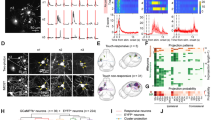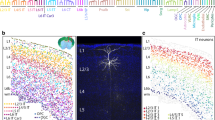Abstract
Reissner's fibre, a thread-like structure present in the central canal of the spinal cord, is a product of the condensation of specific glycoproteins that are released by specialized ependymal cells into the cerebrospinal fluid. These secretory ependymocytes constitute the subcommissural organ, a circumventricular organ that lines the roof of the third ventricle of the brain. The subcommissural organ/Reissner's fibre complex is a permanent structure in the vertebrate central nervous system. The addition of bovine Reissner's fibre itself or of soluble material released by Reissner's fibre to primary mixed cultures of chick cerebral cortical cells markedly enhances neuronal survival. The responsive cells have been identified as neurons by labelling them with antibodies to neurofilament proteins. This neuronal survival effect is dose-dependent and does not require the presence of serum in the culture medium. Affinity-purified polyclonal antibodies raised against bovine Reissner's fibre partially block the effect of Reissner's fibre on neuronal survival. These results suggest that Reissner's fibre is involved in developmental processes of the central nervous system.
Similar content being viewed by others
References
Ang LC, Bhaumick B, Munoz DG, Sass J, Juurlink BHJ (1992) Effects of astrocytes, insulin and insulin-like growth factor I on the survival of motoneurons in vitro. J Neurol Sci 109:168–172
Baier H, Bonhoeffer F (1994) Attractive axon guidance molecules. Science 265:1541–1542
Barde YA (1989) Trophic factors and neuronal survival. Neuron 2:1525–1534
Brenneman DE, Neale EA, Foster GA, d'Autremont SW, Westbrook GL (1987) Nonneuronal cells mediate neurotrophic action of vasoactive intestinal peptide. J Cell Biol 104:1603–1610
Bruel MT, Meiniel R, Meiniel A, David D (1987) Ontogenetical study of the chick embryo subcommissural organ by lectin histofluorescence and electron microscopy. J Neural Transm 70:145–168
Dendy A, Nicholls DV (1910) On the occurrence of the mesocoelic recess in the human brain and its relation to the subcommissural organ of lower vertebrates, with special reference to the distribution of Reissner's fibre in the vertebrate series and its possible function. Proc R Soc Lond [Biol] 82:515–592
Didier R, Meiniel R, Meiniel A (1992) Monoclonal antibodies as probes for the analysis of the secretory ependymal differentiation in the subcommissural organ of the chick embryo. Dev Neurosci 14:44–52
D'Mello SR, Galli C, Ciotti T, Calissano P (1993) Induction of apoptosis in cerebellar granule neurons by low potassium: inhibition of death by insulin-like growth factor I and cAMP. Proc Natl Acad Sci USA 90:10989–10993
Dodd J, Jessell TM (1988) Axon guidance and the patterning of neuronal projections in vertebrates. Science 242:692–699
Engele J, Bohn MC (1991) The neurotrophic effects of fibroblast growth factors on dopaminergic neurons in vitro are mediated by mesencephalic glia. J Neurosci 11:3070–3078
Ermisch A (1973) Zur Charakterisierung des Komplexes Subcommissuralorgan-Reissnerscher Faden und seiner Beziehungen zum Liquor unter besonderer Berücksichtigung autoradiographischer Untersuchungen sowie funktioneller Aspekte. Wiss Z Karl-Marx-Univ Leipzig Math Naturwiss R 22:297–336
Fann MJ, Patterson PH (1994) Neuropoietic cytokines and activin A differentially regulate the phenotype of cultured sympathetic neurons. Proc Natl Acad Sci USA 91:43–47
Hauser R (1972) Morphogenetic action of the subcommissural organ on tail regeneration in Xenopus larvae. Wilhelm Roux Arch Entwickl Mech Org 169:170–184
Iwashita Y, Kawaguchi S, Murata M (1994) Restoration of function by replacement of spinal cord segments in the rat. Nature 367:167–170
Kapuscinski J, Skoczylas B (1977) Simple and rapid fluorimetric method for DNA microassay. Anal Biochem 71:252–257
Karoumi A, Meiniel R, Croisille Y, Belin MF, Meiniel A (1990a) Glycoprotein synthesis in the subcommissural organ of the chick embryo. I. An ontogenetical study using specific antibodies. J Neural Transm Gen Sect 79:141–153
Karoumi A, Croisille Y, Croisille F, Meiniel R, Belin MF, Meiniel A (1990b) Glycoprotein synthesis in the subcommissural organ of the chick embryo. II. An immunochemical study. J Neural Transm Gen Sect 80:203–212
Karoumi A, Meiniel R, Belin MF, Meiniel A (1991) A comparative immunocytochemical and immunochemical analysis of glycoproteins synthesized in the bovine subcommissural organ. J Neural Transm Gen Sect 86:205–216
Kennedy TE, Serafini T, Torre JR de la, Tessier-Lavigne M (1994) Netrins are diffusible chemotropic factors for commissural axons in the embryonic spinal cord. Cell 78:425–435
Leonhardt H (1980) Ependym und circumventriculäre Organe. In: Oksche A, Vollrath L (eds) Neuroglia 1. Springer, Berlin Heidelberg New York, pp 177–665
Letourneau PC, Condic ML, Snow DM (1994) Interactions of developing neurons with extracellular matrix. J Neurosci 14:915–928
Levi-Montalcini R (1987) The nerve growth factor: thirty-five years later. EMBO J 6:1145–1154
Louis JC, Magal E, Takayama S, Varon S (1993) CNTF protection of oligodendrocytes against natural and tumor necrosis factorinduced death. Science 259:689–692
Martin DL (1992) Synthesis and release of neuroactive substances by glial cells. Glia 5:81–94
Meiniel R, Duchier N, Meiniel A (1988) Monoclonal antibody c1B8A8 recognizes a ventricular secretory product elaborated in the bovine subcommissural organ. Cell Tissue Res 254:611–615
Meiniel R, Molat JL, Duchier-Liris N, Meiniel A (1990) Ontogenesis of the secretory epithelium of the bovine subcommissural organ. A histofluorescence study using lectins and monoclonal antibodies. Dev Brain Res 55:171–180
Meiniel R, Didier R, Molat JL, Meiniel A (1993) Developmental aspects of the subcommissural organ: an approach using lectins and monoclonal antibodies. In: Oksche A, Rodríguez EM, Fernandez-Llebrez P (eds) The subcommissural organ. Springer, Berlin Heidelberg New York, pp 51–59
Meiniel R, Creveaux I, Dastugue B, Meiniel A (1995) Specific transcripts analyzed by in situ hybridization in the subcommissural organ of bovine embryos. Cell Tissue Res 279:101–107
Oksche A (1969) The subcommissural organ. J Neuro Visc Relat [Suppl] IX:111–139
Oksche A, Rodríguez EM, Fernandez-Llebrez P (eds) (1993) The Subcommissural Organ: An Ependymal Brain Gland. Springer, Berlin Heidelberg New York
Olsson R (1955) Structure and development of Reissner's fiber in the caudal end of amphioxus and some lower vertebrates. Acta Zool (Stockh) 36:167–198
Patterson PH (1993) Les cytokines et le fonctionnement du système nerveux mature. C R Acad Sci III 316:1141–1149
Reissner E (1860) Beiträge zur Kenntnis vom Bau des Rückenmarks von Petromyzon fluviatilis L. Arch Anat Physiol 1860:545–588
Rodríguez EM, Oksche A, Hein S, Rodríguez S, Yulis R (1984) Comparative immunocytochemical study of the subcommissural organ. Cell Tissue Res 237:427–441
Rühle HJ (1971) Anomalien im Wachstum der Achsenorgane nach experimenteller Ausschaltung des Komplexes Subcommissuralorgan-Reissnerscher Faden. Untersuchungen am Rippenmolch (Pleurodeles waltlii Michah 1830). Acta Zool (Stockh) 52:23–68
Sarnat HB (1992) Role of human fetal ependyma. Pediatr Neurol 8:163–178
Schmalenbach C, Müller HW (1993) Astroglia-neuron interactions that promote long-term neuronal survival. J Chem Neuroanat 6:229–237
Schnell L, Schneider R, Kolbeck R, Barde YA, Schwab ME (1994). Neurotrophin-3 enhances sprouting of corticospinal tract during development and after spinal cord lesion. Nature 367:170–173
Schoebitz K, Garrido O, Heinrichs MS, Peer L, Rodríguez EM (1986) Ontogenetical development of the chick and duck subcommissural organ. An immunocytochemical study. Histochemistry 81:31–40
Serafini T, Kennedy TE, Galko MJ, Mirzayan C, Jessell TM, Tessier-Lavigne M (1994) The netrins define a family of axon outgrowth-promoting proteins homologous to C. elegans UNC-6. Cell 78:409–424
Sterba G, Kleim I, Naumann W, Petter H (1981) Immunocytochemical investigation of the subcommissural organ in the rat. Cell Tissue Res 218:659–662
Sterba G, Kiessig C, Naumann W, Petter H (1982) The secretion of the subcommissural organ. A comparative immunocytochemical investigation. Cell Tissue Res 226:427–439
Takeuchi IK, Takeuchi YK (1986) Congenital hydrocephalus following X-irradiation of pregnant rats on an early gestational day. Neurobehav Toxicol Teratol 8:143–150
Takeuchi IK, Kimura R, Shoji R (1988) Dysplasia of subcommissural organ in congenital hydrocephalus spontaneously occurring in Cws/Idr rats. Experientia 44:338–340
Wagner M, Thaller C, Jessell T, Eichele G (1990) Polarizing activity and retinoid synthesis in the floor plate of the neural tube. Nature 345:819–822
Author information
Authors and Affiliations
Rights and permissions
About this article
Cite this article
Monnerie, H., Boespflug-Tanguy, O., Dastugue, B. et al. Reissner's fibre supports the survival of chick cortical neurons in primary mixed cultures. Cell Tissue Res 282, 81–91 (1995). https://doi.org/10.1007/BF00319135
Received:
Accepted:
Issue Date:
DOI: https://doi.org/10.1007/BF00319135




